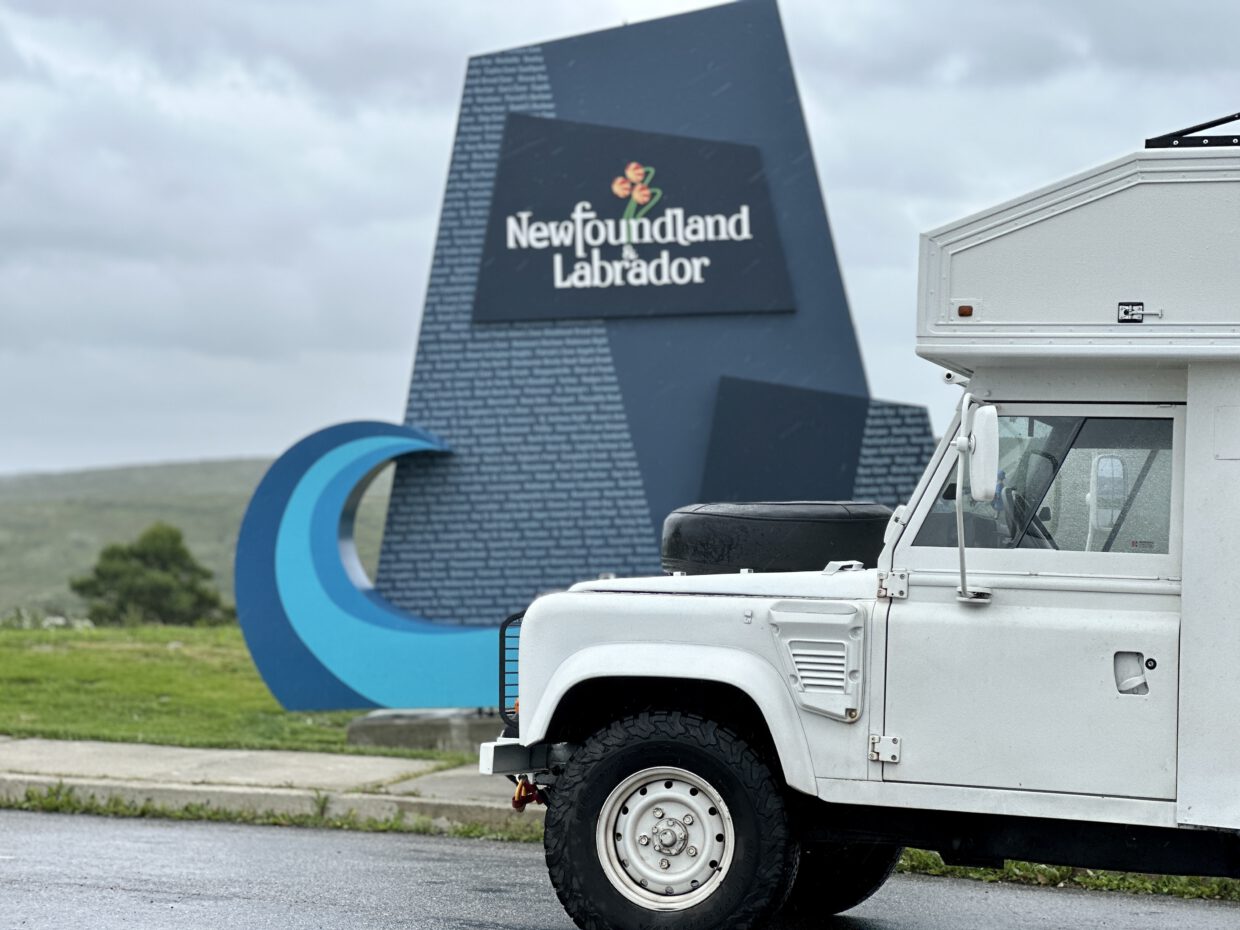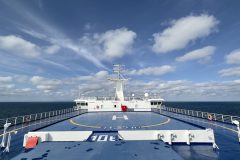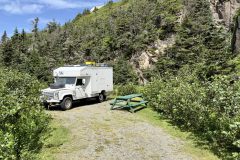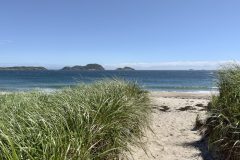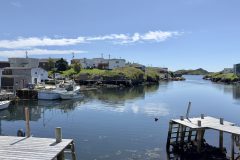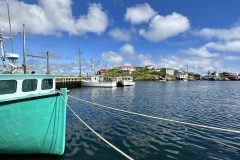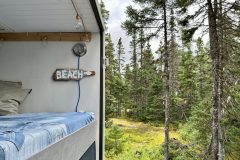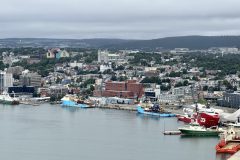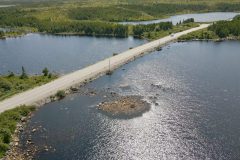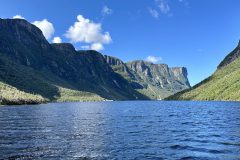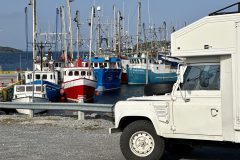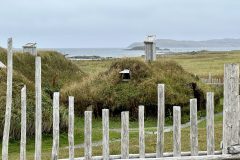+++ english version below +++
Zugegeben, jetzt im September ist der Atlantik schon etwas frisch. Und doch kann ich mir gerade nichts Schöneres vorstellen, als hier im Meer zu schwimmen. Kaum eine Wolke am Himmel, nur eine leichte Brise, die von See aus Richtung Land weht. Dazu eine schöne Brandung. Das Wasser klar wie in der Karibik, der feine Sandstrand fällt ganz flach ab. Manchmal springe ich schon vor dem Frühstück in die Fluten. Manchmal abends kurz vor Sonnenuntergang. So erfrischend und belebend, als würden die Wellen den ganzen Körper durchströmen. Was für eine wundervolle Küste, hier ganz im Süden von Neufundland.
Schon die Überfahrt auf die größte Insel vor Kanadas Ostküste ließ etwas Besonderes erahnen. Und dabei hatte ich gerade erst ein echtes Highlight erlebt: auf dem Cabot Trail, einer der schönsten Küstenstraßen der Welt, die Cape Breton Highlands umrundet. Von North Sydney in der Provinz Nova Scotia bin ich dann per Fähre Richtung Neufundland aufgebrochen. Etwa sieben Stunden dauert die Überfahrt nach Port aux Basques, dem südwestlichsten Punkt der Insel. Weil ich das Meer so liebe, habe ich natürlich eine Tagesüberfahrt gebucht und die meiste Zeit oben auf dem Sonnendeck verbracht. Leider hatte ich nicht das Glück, dabei schon Wale zu sehen. Nur ihren Blas konnte ich in einiger Entfernung entdecken: die mit großem Druck ausgestoßene Ausatemluft, die so feucht ist, dass sie wie eine Art Fontäne aussieht.
Bunte Holzhäuser im überschaubaren Hafen, die ersten Kilometer auf dem Trans Canada Highway, raus aus dem kleinen Küstenort. Die Natur überwältigt mich von Anfang an. Wälder, Weite, wilde Küste. Ein bisschen wie in Skandinavien, ist mein erster Eindruck. Einen ganzen Monat (von Anfang August bis Anfang September) habe ich mir Zeit genommen, die Insel mit meinem Land Rover zu entdecken. Viel Zeit – im Hinblick auf die Gesamtdauer dieses zwölfmonatigen Roadtrips durch Kanada und die USA. Wenig Zeit – wenn ich zurückblickend bedenke, was ich alles nicht anschauen konnte auf dieser Trauminsel.
Hauptverkehrsader hier ist der Trans Canada Highway, eine 900 Kilometer lange, gut ausgebaute Straße, die einen quer über die Insel bis in die Provinzhauptstadt St. John’s ganz im Osten bringt. Abstecher auf kleinere Straßen zum Beispiel auf die nördliche Halbinsel (Great Northern Peninsula) oder an die Südküste sind sehr zu empfehlen. Auch wenn mein Weg über 150 Kilometer Schlaglochpiste nach Burgeo ganz im Süden Neufundlands nicht ganz ohne war: die Anstrengung hat sich mehr als gelohnt. Aus zunächst nur einer geplanten Übernachtung im Sandbanks Provincial Park wurden schnell drei. Und schließlich sogar sieben. Tägliches Bad am Traumstrand des Atlantik inklusive.
Die vielen Provincial Parks auf der Insel sind ohnehin eine gute Anlaufstelle bei der Suche nach einem Stellplatz für die Nacht und gepflegten Sanitäranlagen. Für kleines Geld kann man bereits vorab online reservieren. Aber auch beim spontanen Besuch bekommt man eigentlich fast immer einen Platz, so meine persönliche Erfahrung. Gleiches gilt für die beiden großen Nationalparks auf der Insel: Terra Nova und Gros Morne. Vor allem letzterer war ein echtes Highlight für mich. Mit seinen beeindruckenden Bergen und Wäldern nicht nur ein schöner Kontrast zu den zahlreichen Sandstränden der Insel, sondern auch ein tolles Ausflugsziel für Wanderungen.
St. John’s ist die Hauptstadt der kanadischen Provinz Neufundland und Labrador. Woher sie ihren Spitznamen „Fogtown“ hat, konnte ich bei einem Besuch auf dem Signal Hill, einem Hügel mit hervorragendem Blick über den großen Hafen der Stadt, selbst erleben. Plötzlich zog von See her dichter Nebel auf und hüllte schnell den Hafen und die ganze Stadt ein. Spannend: Hier oben am Cabot Tower wurde 1901 das erste transatlantische Funksignal aus Cornwall empfangen. Trifft man vor allem in St. John’s, aber auch entlang der Ostküste der Insel noch häufiger auf Touristen, so wird das ganz im Norden immer weniger. L’Anse aux Meadows, die historische Ausgrabungsstätte mit einer detailreich rekonstruierten Wikingersiedlung zieht dort vermutlich noch die meisten Reisenden an. Besucht man aber die vielen anderen kleinen Orte entlang der nordwestlichen und nördlichen Küste, erlebt man ein ganz ursprüngliches Neufundland, das noch kaum von Tourismus geprägt ist. Und trifft auf unglaublich hilfbereite und freundliche Einheimische, die einen auch mal nach wenigen Minuten Gespräch am Straßenrand direkt auf einen Tee zu sich nach Hause einladen.
Vielleicht ist es die abgeschiedene Lage, die Neugierde weckt auf die Geschichten der Reisenden. Womöglich aber auch der weite Blick über den Atlantik, der sie offen macht für andere Menschen.
Newfoundland – dream island off Canada’s rugged east coast
Admittedly, the Atlantic is quite a bit fresh in September. And yet I can’t imagine anything more beautiful than swimming here in the sea. Hardly a cloud in the sky, just a light breeze blowing from the sea towards the land. Plus a nice surf. The water is as clear as in the Caribbean, the fine sandy beach slopes very flat. Sometimes I am jumping into the water before breakfast. Sometimes in the evening just before sunset. So refreshing and invigorating, as if the waves were flowing through your entire body. What a wonderful coastline here in the very south of Newfoundland.
The crossing to the largest island off Canada’s east coast already suggested something special. And I had just experienced a real highlight: circling the Cape Breton Highlands on the Cabot Trail, one of the most beautiful coastal roads in the world. From North Sydney in the province of Nova Scotia I took the ferry towards Newfoundland. The crossing to Port aux Basques, the most southwestern point of the island, takes around seven hours. Because I love the sea so much, I of course booked a day trip and spent most of the time up on the sun deck. Unfortunately, I wasn’t lucky enough to see whales. I could only see their breath at some distance: the exhaled air expelled with great pressure, which is so moist that it looks like a kind of fountain.
Colorful wooden houses in the manageable harbor, the first kilometers on the Trans Canada Highway, out of the small coastal town. Nature overwhelmed me from the start. Forests, vastness, wild coast. A bit like Scandinavia, is my first impression. I took a whole month (from the beginning of August to the beginning of September) to discover the island with my Land Rover. A lot of time – considering the total duration of this twelve-month road trip through Canada and the USA. Little time – when I look back and think about what I couldn’t see on this dream island.
The main road here is the Trans Canada Highway, a 900 kilometer long, well-developed road that takes you across the island to the provincial capital St. John’s in the far east. Detours to smaller roads, for example to the Great Northern Peninsula or to the south coast, are highly recommended. Even though my journey over 150 kilometers of a potholed road to Burgeo in the very south of Newfoundland was not entirely without problems, the effort was more than worth it. What was initially planned as just one overnight stay in Sandbanks Provincial Park quickly turned into three nights. And finally even seven. Daily swim on the dream Atlantic beach included.
The many provincial parks on the island are perfect when looking for a place to stay for the night and well-maintained sanitary facilities. You can reserve online in advance for little money. But even if you visit spontaneously, you will almost always get a place, that’s my personal experience. The same applies to the two large national parks on the island: Terra Nova and Gros Morne. The latter in particular was a real highlight for me. With its impressive mountains and forests, it is not only a beautiful contrast to the island’s numerous sandy beaches, but also a great destination for hiking.
St. John’s is the capital of the Canadian province of Newfoundland and Labrador. I was able to see for myself where it got its nickname “Fogtown”, during a visit to Signal Hill, a hill with an excellent view over the city’s large harbor. Suddenly a thick fog rolled in from the sea and quickly enveloped the harbor and the entire city. Exciting: The first transatlantic radio signal was received up here at Cabot Tower in 1901 from Cornwall. Here in St. John’s and also along the east coast of the island tourists are very common. When you are going up north you will find fewer and fewer tourists. L’Anse aux Meadows, the historical excavation site with a detailed reconstructed Viking settlement, probably still attracts the most travelers there. But if you visit the many other small towns along the northwest and northern coast, you will experience a very original Newfoundland that is hardly yet influenced by tourism. And you meet incredibly helpful and friendly locals who, after just a few minutes of conversation on the side of the road, invite you straight to their home for tea.
Perhaps it is the remote location that arouses curiosity about the travelers‘ stories. And maybe also the wide view over the Atlantic, which makes them open to other people.

